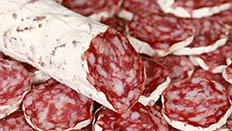Meats and Sausages
Salame Piacentino
The Salame Piacentino is produced in the whole province of Piacenza, but includes only those parts below 900 m above sea level, where particular climatic conditions prevail. It is made with lean pork and pork fat at between 10% and 30%. The finished product is cylindrical in shape; its slices are bright red in color, with visible chunks of pinkish white fat. It has a particular, very intense, rather sweet flavor with a characteristic aroma of sausage meat.
| Meats | Metric | US |
|---|---|---|
| Lean pork | 700 g | 1.54 lb |
| Back fat, pork belly | 300 g | 0.66 lb |
Ingredients per 1000g (1 kg) of meat
| Salt | 28 g | 5 tsp |
| Cure # 2 | 2.5 g | 1/2 tsp |
| Pepper | 1.0 g | 1/2 tsp |
| Peppercorns, whole | 1.0 g | 1/2 tsp |
| Dextrose | 3.0 g | 1/2 tsp |
| Sugar | 2.0 g | 1/3 tsp |
| Nutmeg | 0.5 g | 1/4 tsp |
| Garlic | 7.0 g | 2 cloves |
| White or red wine | 5 ml | 1 tsp |
| Starter culture, T-SPX | 0.12 g | use scale |
Instructions
- Grind meat through 3/8” (10 mm) plate.
- Cut fat into 1/4” (6 mm) cubes.
- Dissolve starter culture in 1 tablespoon de-chlorinated water 30 minutes before mixing step.
- Mix ground meat with salt and cure #2.
- Add fat, spices, wine and culture to the mixture and re-mix.
- Stuff into 40 mm hog casings.
- Ferment at 20º C (68º F) for 72 hours, 90 → 85% humidity.
- Dry at 15→12º C (59→54º F), 85→75% decreasing humidity for 45 days. The sausage is dried until around 30-35% in weight is lost.
- Store sausages at 10-15º C (50-59º F), <75% humidity.
Notes
The finished product must bear the words ‘Salame Piacentino’ which must appear on the label in clear, indelible letters fully distinguishable from any other wording and be followed immediately by the term ‘Denominazione di Origine Protetta’ (protected designation of origin).
The geographical production area and history
The ‘Salame Piacentino’ production area covers the whole of the province of Piacenza, but includes only those parts below 900 m above sea level, where particular climatic conditions prevail. The production of ‘Salame Piacentino’ began during the Roman period and has been passed down over time, concentrated in the geographical area of Piacenza province. The importance of the ‘Salame Piacentino’ production area ties in with the development of a typical rural culture common to the entire Po valley, from where the raw material is sourced (Emilia Romagna and Lombardy). In the area which is the source of the raw material, the development of livestock farming is linked to the widespread cultivation of cereal crops and to working methods in the highly specialized dairy sector which have encouraged pig farming locally. Producers in Piacenza province have developed and passed down through time their specific abilities in selecting the cuts of meat and processing the lean and fat portions. In addition, the presence of cool, water-rich valleys and wooded hills has a positive influence on the conditions for maturation. The environmental factors are closely linked with the characteristics of the production area and in particular its climate, which has a vital impact on the characteristics of the finished product, contributing to the successful maturing of the Salame Piacentino.
Production
Meat for ‘Salame Piacentino’ comes from heavy pigs that are born, raised and slaughtered in Emilia Romagna and Lombardy. The feeding of the pigs takes place in two stages and is mainly based on cereal products. The average feed ration mainly consists of maize mash followed by barley, bran, soya and mineral supplements. Cheesemaking by-products (whey, curds and buttermilk) mostly come from cheesemakers in the identified geographical area.
Meat: lean pork; hard fat (10 – 30% of meat total) such as back fat, jowls, pork belly without soft fat.
Ingredients: salt 1.3 – 3.5%, potassium nitrate (E252), max 150 ppm (parts per million), sodium nitrite max 100 ppm; black or white pepper, whole and/or ground 0.3-0.5g/1kg; sugar 15 g/1kg max; sodium ascorbate (E301): 0.2 g/1 kg max, nutmeg 0.3 g/1 kg max; garlic 0.5 – 2.0 g/1 kg, wine 1 – 5 ml/kg, garlic in wine infusion max 5 ml/1 kg. Adding starter cultures is allowed to ensure that the fermentation process begins strongly.
Processing: lean meat and fat are ground through 10 - 12 mm (3/8 – 1/2”) grinder plate. The ground meat and fat is mixed with all ingredients and garlic infusion which was made by soaking diced garlic in wine for 6 hours. The meat paste is stuffed into < 70 mm diameter natural hog casings (no bigger than 70 mm). The stuffed sausage is reinforced with butcher twine. The sausages are than held at 15 – 25° C (59 – 77° F), 40-90% humidity to start drying/fermentation process. The, the sausages are submitted to drying/maturing period at 12 – 19° C (53 – 66° F), 70-90% humidity that continues for at least 45 days starting the count when the sausages were stuffed. The salmi’s acidity level pH: > 5.2 results in product with a mild flavor.
The introduction of the use of nitrites, within the legal limits, is required because the presence of nitrites and nitrates gives the salami greater resistance against diseases and oxidation during the production phase of ‘Salame Piacentino’ PDO. The inclusion of nutmeg into the salting mixture is requested in order to have a modern alternative to the traditional production recipe.


















